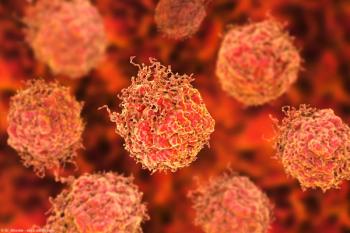
Bladder-sparing, nivolumab-based strategy shows promise in MIBC
The phase 2 HCRN GU16-257 trial explored the bladder-sparing regimen of TURBT plus nivolumab and chemotherapy in patients with muscle-invasive bladder cancer.
Combining transurethral resection of the bladder tumor (TURBT) with nivolumab (Opdivo) and chemotherapy showed promise as a bladder-sparing treatment strategy in patients with muscle-invasive bladder cancer (MIBC), according to findings from the phase 2 HCRN GU16-257 trial presented at the 2021 ASCO Annual Meeting.1
In the study, the bladder-sparing approach achieved stringently-defined clinical complete responses (CRs) in a large subset of patients with MIBC. Commenting on the results, lead study author Matthew D. Galsky, MD, said, “Bladder-intact recurrence-free survival is possible [with this strategy], although the durability of responses requires longer follow-up.”
Explaining the rationale for the trial, Galsky said, “Radical cystectomy is a major operation and requires diversion of the urinary stream, which has life-altering implications. Clearly, if we could identify which patients can have their muscle-invasive bladder cancer eradicated with TURBT plus systemic therapy alone, a subset of patients could avoid cystectomy and enjoy long-term, bladder-intact disease free-survival.”
The phase 2 HCRN GU16-257 study enrolled 76 patients with cisplatin-eligible cT2 to T4aN0M0 clinically localized urothelial bladder cancer. Galsky noted that, “Due to COVID-19, there was some gap between enrollment of the first 64 patients and the remaining patients.” The median age was 69 years (range, 39-85) and 79% of patients were male. Tumor stages at baseline were cT2 (57%), cT3 (32%), and cT4 (12%). Regarding histology, 76% of patients had urothelial cancer that was transition cell and 24% of patients had urothelial cancer with variant histology.
Patients initially received 4 cycles of gemcitabine plus cisplatin plus nivolumab. Following these 4 cycles, all patients underwent clinical restaging, including MRI/CT of the bladder (unless otherwise contraindicated), urine cytology, and cystoscopy with bladder/prostatic urethral biopsies.
Patients with a clinical CR could then opt to proceed with cystectomy or proceed without cystectomy and instead receive an additional 4 months of single-agent nivolumab. For patients without a clinical CR, a cystectomy was recommended.
The study had two coprimary end points: 1) determine the clinical CR rate of this regimen and 2) determine the ability of a clinical CR to predict “benefit” from treatment. A clinical CR was defined as having no abnormalities on post–treatment cycle 4 imaging, no abnormalities on post–treatment cycle 4 urine cytology, and either no evidence of disease or no evidence of disease greater than low-grade papillary tumors (Ta) on post–treatment cycle 4 mapping biopsies of the bladder.
For the second primary end point, “benefit” was defined as being metastasis-free for 2 years in patients opting for no cystectomy or achieving a pathologic CR in patients receiving cystectomy.
At the time of the data cutoff, 64 patients had completed clinical restaging. Of these patients, 31 (48%; 95% CI, 36-61) achieved a clinical CR. Thirty of these patients chose not to undergo cystectomy and instead receive an additional 4 months of nivolumab monotherapy. Only 1 patient opted for immediate cystectomy. “On surgical pathology, that patient had a low-grade papillary tumor,” said Galsky. The remaining 33 patients did not reach a clinical CR and cystectomy was recommended.
Galsky noted that all 31 patients who achieved a clinical CR are still alive and “there are a number of patients who are now 12 months out since treatment initiation who have had no recurrence and whose bladders remain intact.”
There were 6 patients with a clinical CR who underwent delayed cystectomy after local recurrence. Of these patients there was 1 patient each with a pathological stage of ypT0N0, ypTaN0, YpTisN0, and ypT4N1, and 2 patients with a stage of ypT2N0.
Among 28 patients who did not reach a clinical CR and underwent immediate cystectomy, the pathological stages were ypT0N0 (n = 2), YpTisN0 (n = 5), ypT1N0 (n = 3), ypT2N0 (n = 5), ypT3N0 ( n = 3), ypT4N0 (n = 1), and ypTanyN+ (n = 9).
Galsky noted that no patients had to stop study treatment early for any of the trial-defined stopping rules, which included a high rate of grade 3/4 immune-related adverse events (AEs; all patients) or a high rate of muscle-invasive and/or metastatic recurrence rates (patients achieving a clinical CR). Further, the AE profile was consistent with other recent trials evaluating the combination of cisplatin-based chemotherapy with immune checkpoint blockade in this setting.
Regarding next steps, Galsky said, “A suite of genomic and radiomic biomarkers are being explored in an effort to refine the ability of clinical CR to predict long-term bladder-intact recurrence-free survival.”
Reference
1. Galsky MD, Daneshmand S, Chan KG et al. Phase 2 trial of gemcitabine, cisplatin, plus nivolumab with selective bladder sparing in patients with muscle- invasive bladder cancer (MIBC): HCRN GU 16-257. J Clin Oncol 39, 2021 (suppl 15; abstr 4503). doi: 10.1200/JCO.2021.39.15_suppl.4503
Newsletter
Stay current with the latest urology news and practice-changing insights — sign up now for the essential updates every urologist needs.


















